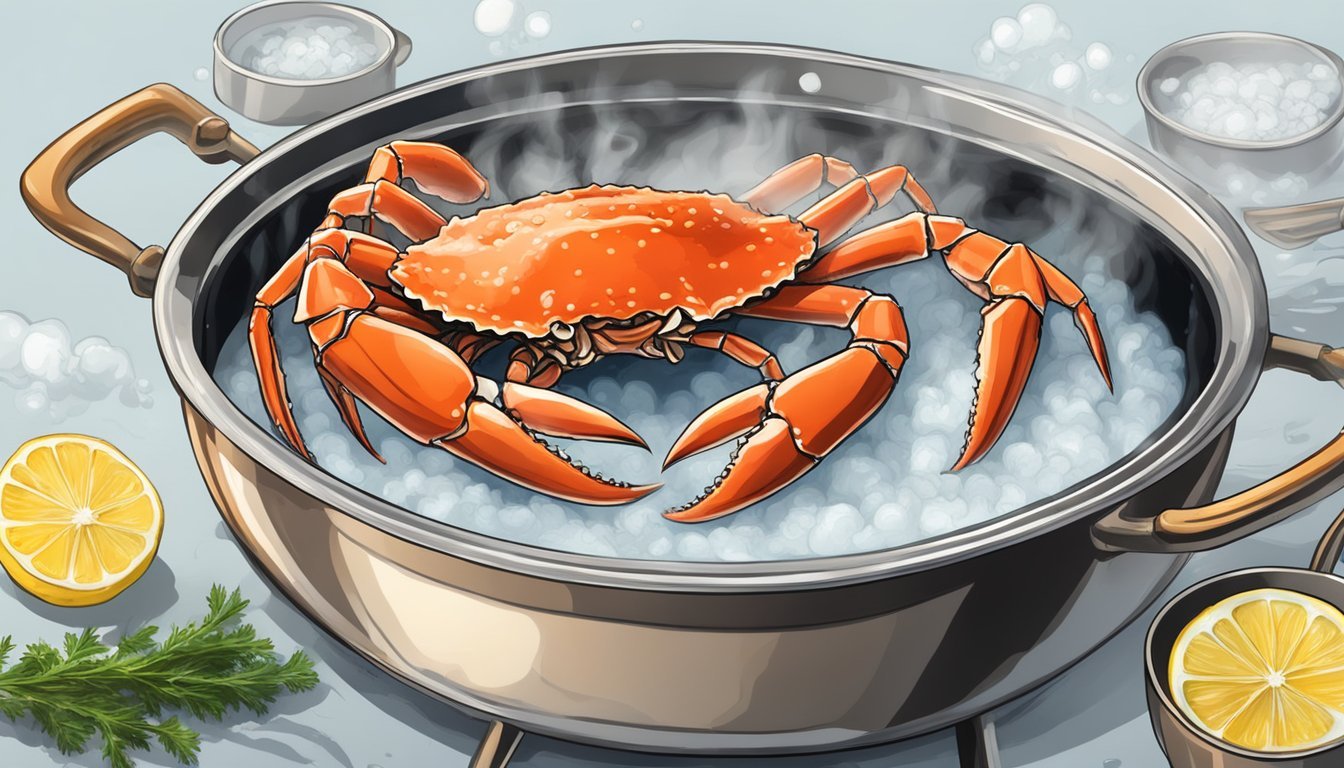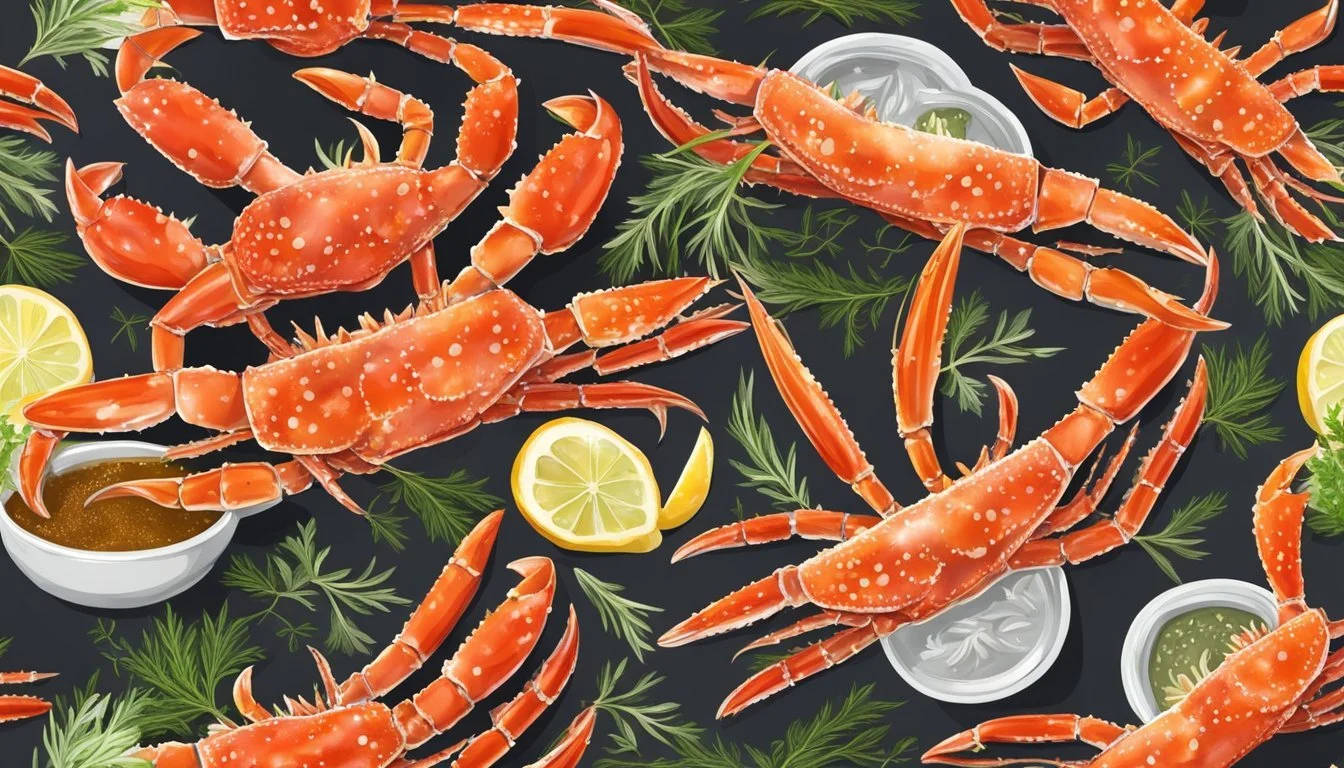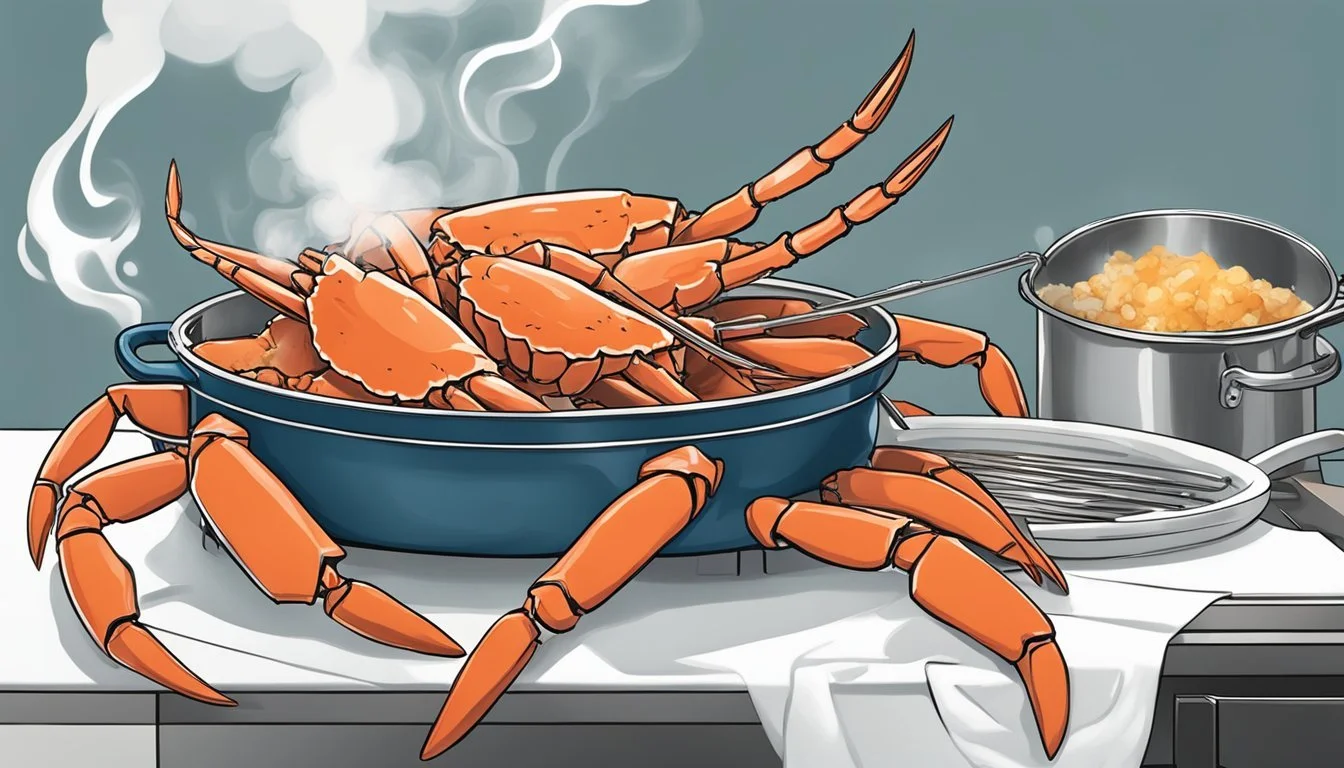How to Cook King Crab Legs
Mastering the Art of Succulent Seafood
King crab legs are a delicacy that can be prepared at home with ease. These succulent crustaceans offer a sweet, tender meat that's prized by seafood lovers worldwide. Cooking king crab legs is simple and can be done through various methods, including boiling, steaming, grilling, or baking.
Alaskan king crab is renowned for its large size and exceptional flavor. When cooking these legs, it's crucial to handle them gently to preserve their delicate texture. Most king crab legs are pre-cooked and frozen, so the main goal is to reheat them without overcooking.
The cooking time for king crab legs varies depending on the method chosen and whether they're thawed or frozen. Typically, thawed legs require about 5-8 minutes of cooking, while frozen legs may need 10-12 minutes. Regardless of the technique used, the result should be perfectly warmed crab meat that's ready to be enjoyed with melted butter, lemon wedges, and your favorite seasonings.
Understanding King Crab
King crab is a prized seafood delicacy known for its large size and sweet, succulent meat. These crustaceans offer impressive nutritional benefits and come in several varieties, each with unique characteristics.
Species and Varieties
King crabs belong to the family Lithodidae and include three main commercial species. The red king crab is the largest and most sought-after variety, found in the Bering Sea and North Pacific Ocean. Blue king crabs are slightly smaller with a more intense flavor, while golden king crabs are the smallest of the three.
Red king crabs can reach leg spans of up to 6 feet and weigh up to 20 pounds. Blue king crabs typically weigh between 5-8 pounds. Golden king crabs are generally 5-8 pounds in weight.
Each species has distinct habitat preferences and harvesting seasons, which affect their availability and price in the market.
Nutritional Value
King crab meat is highly nutritious and low in calories. It's an excellent source of high-quality protein, essential for muscle growth and repair. A 3-ounce serving provides about 16 grams of protein.
King crab is rich in vitamins and minerals. It contains significant amounts of vitamin C, supporting immune function and collagen production. The meat also provides vitamin A, important for eye health and immune function.
Calcium is present in king crab, contributing to bone health. Other minerals found in king crab include zinc, selenium, and phosphorus.
Selecting Quality Crab Legs
When choosing king crab legs, look for a vibrant color without discoloration. Red king crab legs should have a bright red-orange hue. Avoid legs with black spots or yellowing, which may indicate spoilage.
Fresh king crab legs should have a mild, sweet aroma. Any strong fishy smell is a sign of deterioration. The shell should be firm and intact, without cracks or soft spots.
Size is an important factor in selection. Larger legs generally contain more meat and are easier to eat. For optimal freshness, purchase frozen crab legs and thaw them just before cooking.
Properly stored, frozen king crab legs can maintain quality for 4-6 months. Thawed crab legs should be consumed within 1-2 days for the best flavor and texture.
Preparation Essentials
Proper preparation is key to cooking delicious king crab legs. Thawing frozen crab legs correctly and cleaning them thoroughly ensures the best taste and texture.
Thawing Frozen Crab Legs
Thaw frozen king crab legs in the refrigerator for 8-12 hours before cooking. This gradual process preserves flavor and texture.
For quicker thawing, place crab legs in a sealed plastic bag and submerge in cold water. Change the water every 30 minutes. This method takes about 1 hour per pound.
Never thaw crab legs at room temperature or use hot water, as this can promote bacterial growth and affect quality.
Once thawed, cook the crab legs within 24 hours for optimal freshness.
Cleaning and Cutting
Rinse thawed crab legs under cold running water to remove any ice crystals or debris. Pat dry with paper towels.
Use kitchen shears to cut along the shell's soft underside for easier meat extraction after cooking. This step is optional but can enhance the dining experience.
For larger crab legs, consider cutting them into smaller sections to fit in your cooking vessel.
Brush the crab legs lightly with olive oil or melted butter to enhance flavor and prevent sticking during cooking.
Place prepared crab legs in a colander to drain excess water before cooking.
Cooking Techniques for King Crab Legs
King crab legs can be prepared using several methods, each offering unique flavors and textures. The most common techniques include boiling, steaming, baking, and grilling.
Boiling King Crab Legs
Boiling is a quick and simple method for cooking king crab legs. Fill a large pot with water, adding salt for seasoning. Bring the water to a rolling boil over high heat.
Carefully lower the crab legs into the pot using tongs. For thawed legs, cook for 5-8 minutes. Frozen legs require 10-12 minutes of boiling time.
Once cooked, remove the crab legs from the water with tongs. Drain excess water before serving. Boiling helps preserve the natural flavors of the crab meat while ensuring even cooking throughout.
Steaming King Crab Legs
Steaming is an excellent technique for retaining moisture and delicate flavors. Fill a large pot with about 2 inches of water and place a steamer basket inside.
Bring the water to a boil, then reduce heat to medium. Arrange the crab legs in the steamer basket, making sure they're not overcrowded.
Cover the pot and steam for 6-8 minutes for thawed legs, or 10-12 minutes for frozen ones. The crab is ready when it's heated through and emits a fragrant aroma.
Baking King Crab Legs
Baking allows for infusion of additional flavors. Preheat the oven to 350°F (175°C). Place crab legs in a single layer on a baking sheet.
Brush the legs with melted butter or olive oil. For extra flavor, add minced garlic or herbs. Cover the baking sheet with aluminum foil to trap moisture.
Bake for 8-10 minutes for thawed legs, or 15-18 minutes for frozen ones. The crab is done when it's hot throughout and the shell turns a bright red color.
Grilling King Crab Legs
Grilling imparts a smoky flavor to king crab legs. Preheat the grill to medium-high heat. Brush the crab legs with olive oil to prevent sticking.
Place the legs directly on the grill grates. For indirect heat, turn off the center burner and place the legs in the middle of the grill.
Grill for 5-7 minutes, turning once halfway through. The crab is ready when the shell is hot to the touch and the meat is warmed through.
For added flavor, place a small skillet with butter and garlic on the grill alongside the crab legs. Use this mixture for basting or as a dipping sauce.
Enhancing Flavors
King crab legs have a naturally sweet and delicate flavor that can be further elevated with complementary ingredients. Proper seasoning and sauces enhance the taste without overpowering the succulent meat.
Butter and Garlic Sauce
Butter and garlic create a classic pairing for king crab legs. Melt unsalted butter in a small saucepan over low heat. Add minced garlic and sauté for 30 seconds until fragrant.
For extra depth, incorporate a splash of white wine or lemon juice. Brush this mixture onto the crab legs before grilling or serve it as a dipping sauce.
The richness of butter amplifies the crab's natural sweetness, while garlic adds a savory note. This combination brings out the best in king crab meat without masking its delicate flavor.
Lemon and Herbs
Lemon and herbs provide a bright, fresh contrast to the rich crab meat. Squeeze fresh lemon juice over cooked crab legs just before serving. The acidity cuts through the richness and enhances the seafood's natural flavors.
Finely chop fresh herbs like parsley, dill, or chives. Sprinkle them over the crab legs or mix into melted butter for a herb-infused dipping sauce.
For a zesty twist, combine lemon zest with herbs and sprinkle this mixture over the crab legs. The citrus oils in the zest add intense flavor without excess moisture.
Seasonings and Spices
Seasoning blends can add complexity to king crab legs. Old Bay seasoning, a classic seafood mix, contains celery salt, paprika, and red pepper. It complements the crab's sweetness with its blend of spices.
Cajun seasoning offers a bolder flavor profile with paprika, garlic powder, and cayenne pepper. Use it sparingly to avoid overpowering the delicate crab meat.
For a simpler approach, combine salt, black pepper, and paprika. This basic blend enhances the crab's natural flavors without adding competing tastes.
Apply dry seasonings before cooking or sprinkle them over cooked crab legs for added flavor and visual appeal.
Olive Oil Drizzle
A light drizzle of high-quality olive oil can enhance king crab legs. Choose extra virgin olive oil for its robust flavor and aroma. Brush a small amount onto the crab legs before grilling to prevent sticking and add subtle flavor.
After cooking, drizzle a small amount of olive oil over the crab legs. This adds a fruity note and pleasant mouthfeel that complements the sweet meat.
For an infused oil, gently heat olive oil with garlic cloves or herbs. Strain and use this flavored oil as a finishing touch or dipping sauce for the crab legs.
Serving and Presentation
King crab legs deserve an elegant presentation to showcase their impressive size and succulent meat. Proper serving techniques and thoughtful accompaniments elevate the dining experience.
Pairing with Sides
Complement king crab legs with light, refreshing sides that enhance rather than overpower their delicate flavor. A crisp green salad with a citrus vinaigrette provides a bright contrast. Steamed vegetables like asparagus or broccoli offer a healthy, colorful addition to the plate.
For a heartier option, serve the crab legs alongside a small portion of pasta tossed in garlic and olive oil. Roasted potatoes seasoned with herbs make an excellent starchy side dish.
Avoid heavy, creamy sauces that might mask the crab's natural sweetness. Instead, offer melted butter and lemon wedges on the side for diners to use as desired.
Serving Tools
Equip diners with the proper tools to fully enjoy their king crab legs. Provide seafood crackers or kitchen shears to easily access the meat inside the shell. Include small forks or picks for removing meat from hard-to-reach places.
Set out finger bowls filled with warm water and lemon slices for easy cleanup during the meal. Offer plenty of napkins or moist towelettes, as eating crab legs can be a messy affair.
Consider using crab forks or cocktail forks for a more refined dining experience. These smaller utensils make it easier to maneuver the delicate crab meat.
Decorative Touches
Create an eye-catching presentation by arranging the king crab legs on a large platter or individual plates. Garnish with fresh herbs like parsley or dill for a pop of color. Lemon wedges not only serve a practical purpose but also add visual appeal.
For a dramatic effect, serve the crab legs on a bed of crushed ice to keep them chilled and create a seafood restaurant ambiance. Use edible flowers or microgreens as garnishes for an upscale touch.
Consider incorporating nautical elements in your table setting, such as seashells or blue and white linens, to enhance the seafood theme. Candles or soft lighting can create a cozy atmosphere for enjoying this luxurious meal.
Ensuring Perfect Doneness
Achieving the ideal doneness for king crab legs requires attention to key indicators and proper technique. Mastering visual cues, timing, and temperature control will help you avoid common pitfalls and produce consistently delicious results.
Visual Cues
The appearance of king crab legs provides valuable information about their doneness. As they cook, the shells transition from a deep red to a brighter orange-red hue. The meat itself should become opaque and take on a pearly white color.
When perfectly cooked, the flesh will easily separate from the shell. Gently pull back a section of the shell - if the meat comes away cleanly, it's likely ready. Overcooking can cause the meat to shrink and become stringy.
Look for small cracks or splits in the shell. These indicate that the heat has fully penetrated the crab leg, often signaling doneness.
Timing and Temperature
Precise timing is crucial for perfectly cooked king crab legs. Thawed legs typically require 6 to 10 minutes of steaming, while frozen legs need 12 to 15 minutes.
For oven-baked crab legs, preheat to 350°F (175°C). Bake thawed legs for 7 to 10 minutes. Frozen legs may need 15 to 18 minutes.
When grilling, aim for medium-high heat (around 450°F or 232°C). Cook thawed legs for 5 to 7 minutes, turning once. Frozen legs may need 8 to 10 minutes.
Use a meat thermometer to check internal temperature. The crab is done when it reaches 145°F (63°C) at the thickest part.
Avoiding Common Mistakes
Overcooking is the most frequent error when preparing king crab legs. It leads to tough, rubbery meat that's difficult to remove from the shell. Set a timer and check for doneness a minute or two before the recommended cooking time.
Don't submerge crab legs in water when boiling or steaming. Use a steamer basket or rack to keep them above the water line. This preserves flavor and texture.
Avoid using high heat, which can cause uneven cooking. Stick to medium or medium-high temperatures for consistent results.
Never thaw crab legs at room temperature. Defrost them in the refrigerator overnight or use cold running water for quicker thawing.
Resist the urge to repeatedly open the oven, grill, or pot lid. This releases heat and steam, extending cooking time and potentially drying out the meat.
After-Cooking Care
Proper handling of leftover crab legs and effective reheating techniques ensure maximum flavor and food safety. These practices preserve the delicate texture and taste of king crab for future enjoyment.
Handling Leftovers
Store leftover king crab legs promptly to maintain quality. Remove the meat from the shells and place it in an airtight container. Refrigerate within two hours of cooking. Cooked crab meat keeps for 3-5 days in the refrigerator.
For longer storage, freeze crab meat in moisture-proof packaging. It remains safe indefinitely but tastes best when used within 3 months. Label containers with the date to track freshness.
Discard any crab left at room temperature for over 2 hours. This prevents bacterial growth and potential foodborne illness.
Reheating Techniques
Gentle reheating preserves the crab's texture and flavor. Thaw frozen crab in the refrigerator overnight before reheating.
Steaming is an excellent method. Place crab in a steamer basket over boiling water for 2-3 minutes until hot.
For microwave reheating, wrap crab in damp paper towels. Heat in 30-second intervals, checking frequently to avoid overcooking.
Oven reheating works well for larger portions. Place crab in a baking dish with a splash of water. Cover with foil and heat at 350°F for 10-15 minutes.
Avoid boiling when reheating, as it can make the meat tough and waterlogged.




